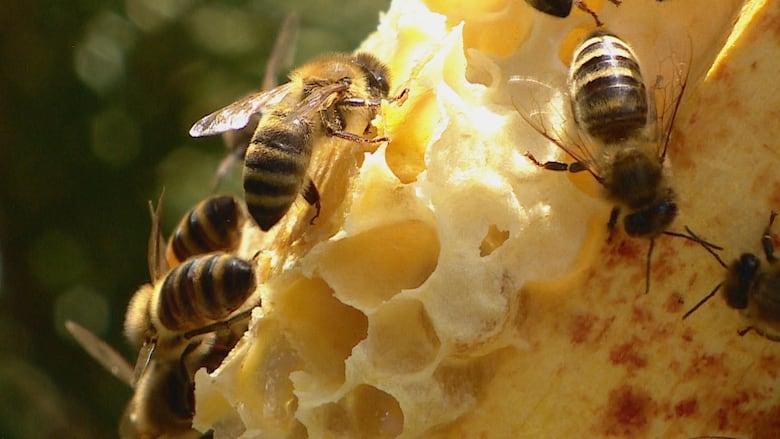Could honeybees help us understand FASD? This Saskatoon researcher watches hives for clues
Honeybees have similar qualities to humans, making them a good model for human conditions, says Wood

A researcher from Saskatoon wants to learn more about the effects of Fetal Alcohol Spectrum Disorder (FASD) by using honeybees.
Sarah Wood, research chair in pollinator health at University of Saskatchewan, has looked at how FASD affects the movements of bees, and now she is looking to see how it may affect bees socially.
"There's this genetic connection between the social behaviour of honeybees and humans that we thought we'd like to explore in the context of FASD," said Wood.
She says a previous study that looked at honeybees is a potential model for autism in humans.
"What they found was that for honeybees that were socially non-responsive in certain situations, they had some of the same genes unregulated as humans with autism," said Wood.
Her research around FASD is already being carried out and led by a masters student who is raising honeybees in the lab — from larvae to adults.
At the same time, Wood says they include low concentrations of ethanol through the larval diet to observe how it impacts the development of the honeybee until they are fully grown.
Honeybees are then introduced to an observation hive.
"This is a glass-sided hive where we can observe the behaviour of the honeybees and we can look at how they interact with their nest mates, how they share food, how they communicate and also how the bees interact with their queen," she said.
Each honeybee will be identified by a numbered tag attached to their thorax so they will be easy to identify and compare the treatments and controls, said Wood.
Link between bees and humans
Wood says honeybees are a eusocial species where they have cooperative brood care — they work together to care for larvae and have overlapping generations.
"And they have division of labour," said Wood, noting that different ages of bees have different jobs in the hive.
"All of those properties, you know, we can sort of see in our own human society. And so perhaps it's not surprising that honeybees might be a good model for human conditions," she said.
Stephen Pernal, a research scientist at Agriculture and Agri-Food Canada, says honeybees offer a lot of potential when it comes to looking at the progression of a disease and what factors may affect it.
"Now with the advent of genetic technologies, we can look at gene expression," said Pernal.
"And we do know, some of the genes that honeybees have are common in terms of expression between autism in people and an insect."
He says "animal models" are commonly used for research because it would be unethical to treat humans with disease to look for cures or at progressions of the disease.
"They could be fish, they could be things like worms, like nematodes and in fact sometimes insects are used in animal models as well," said Pernal.
Beyond ethics, Pernal says using an animal model is often cheaper and quicker when it comes to getting answers to the questions that may want to be used in a human model.
"Honeybees are super social. They have co-operative group care, they have division of labour, they have tasks which reduce diseases by social skills," said Pernal.
He says a honeybee's social behaviour can be characterized by observing their role in a hive.
"I believe the idea is if you were to expose honeybees to some sort of threat, in this case alcohol, we could look at their effects on their social skills as adults and use that as a model to compare what might actually happen in people."
Pernal says there aren't a lot of other systems that could be used to explore changes in adult behaviours and socialization in other animals.
What the research shows so far
Wood says when looking at how the ethanol affects a bee's development, they noticed the honeybees that have been exposed to higher concentrations of ethanol have covered less distance compared to those that had less.
"They weren't moving normally compared to the controls," she said.
Looking forward, Wood says the more immediate outcome of her research would be to spark more positive conversations around FASD and support for the families affected.
"The long-term goal for this research would be to develop a drug discovery animal model as sort of a cheap and easy model that we could use to screen potential therapeutics for treatment of FASD," she said.

